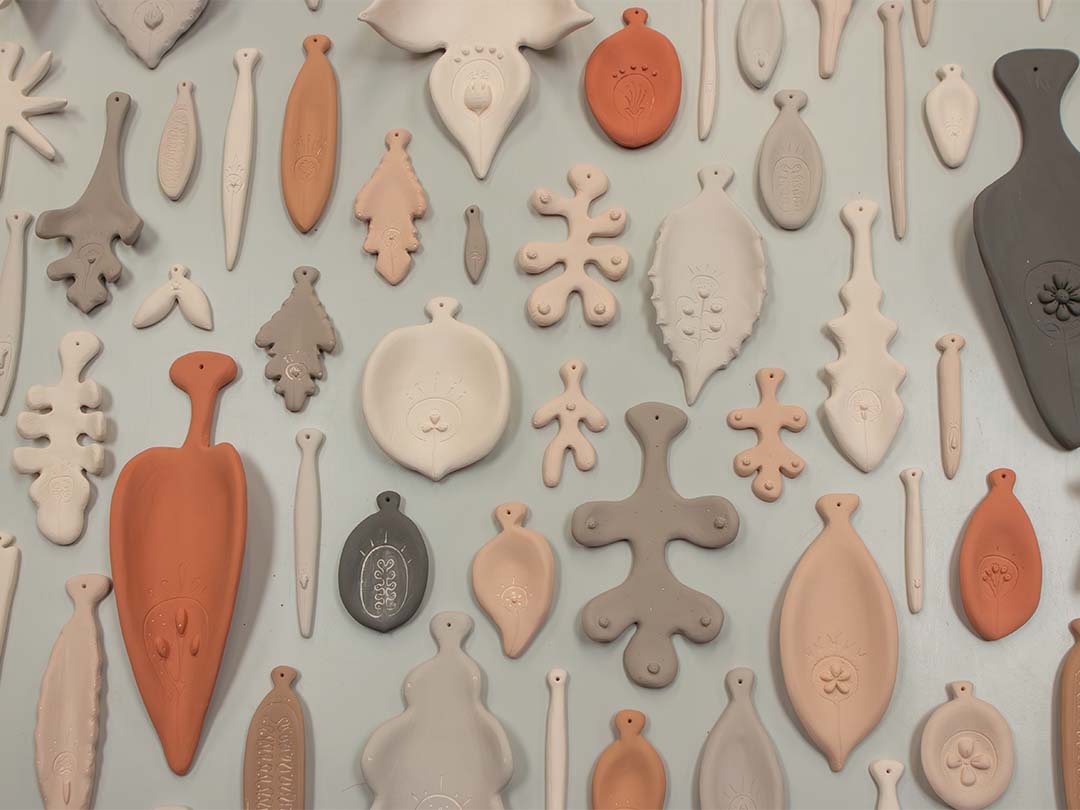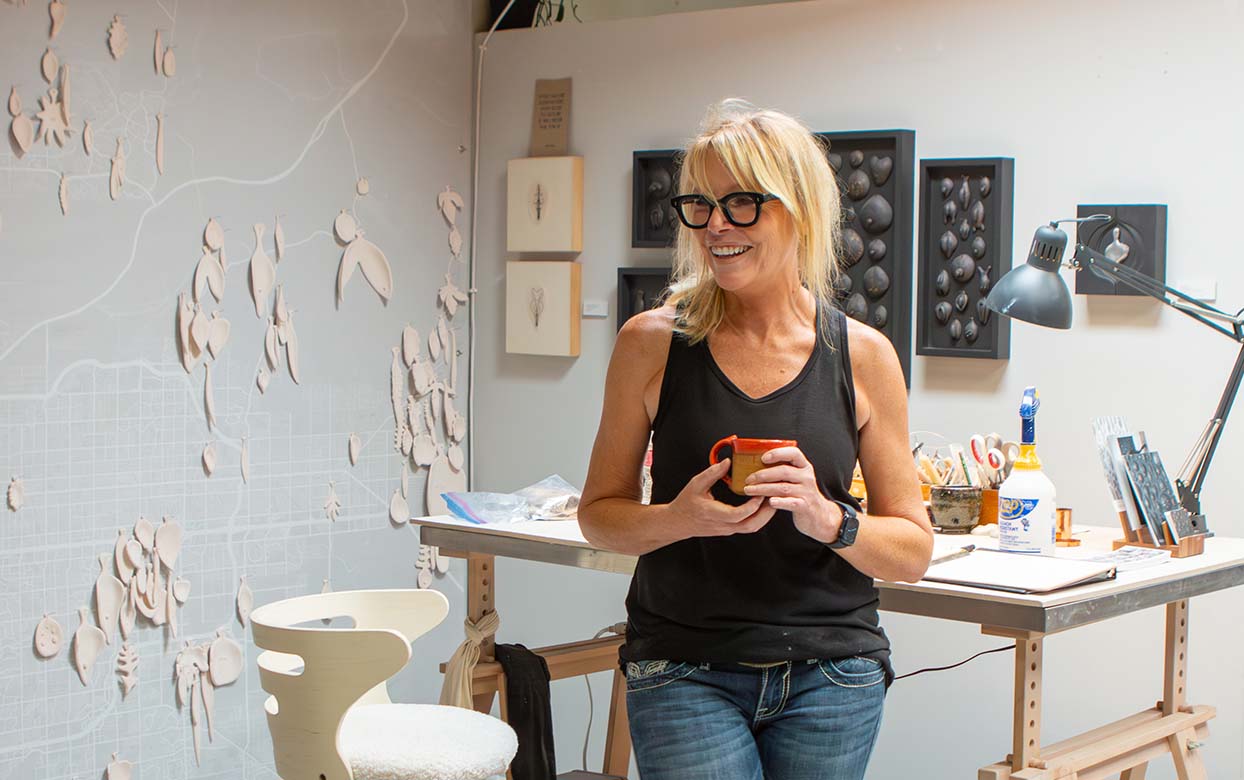On Aug. 24, Desert Botanical Garden will debut its first art exhibition — The Leaf Connection —inside Webster Center.
A mosaic of more than 1,000 ceramic leaves intricately pinned to a map of metro Phoenix, The Leaf Connection is an enticing exhibit created by local sculptor and mixed media artist Mary Meyer that showcases the diversity of the plants found across the city. Meyer draws inspiration for each leaf from observations community scientist record on iNaturalist, an established online platform where nature lovers share information on biodiversity. During the course of the exhibit, Mary will periodically add new ceramic leaves as more observations are uploaded on iNaturalist.
Before the exhibit opens to the public, learn more about Meyer in this Q&A as delves into her background, previous works and explains the importance of her upcoming exhibit at the Garden.

Q: What was the inspiration of this exhibit?
A: The Leaf Connection stems from my desire to make work that is closely tied to my home community and the Sonoran Desert. For the past several years, I’ve used ceramic leaves as symbols of our human connection to nature. I wanted to create an exhibit that would foster that connection and bring awareness to our natural surroundings — one that would result in work that is accessible, relevant and meaningful to those who experience it. The idea for it emerged when I was introduced to iNaturalist through Metro Phoenix Ecoflora. Using iNaturalist as a research tool and database provided a way to make work that is intimately tied to the community while contributing biodiversity information that supports local conservation. The project initially began as a partnership with Metro Phoenix Ecoflora and was launched on iNaturalist in March 2022.
Q: Why is the community aspect important to you?
A: Community is the heart and soul of this exhibit. It drives and energizes the project. The leaves I make are derived from living data and created in direct response to Valley residents and the plants that grow here. I have connected with a wide range of people who I might not have crossed paths with otherwise, including a large network of citizen scientists on iNaturalist. Many are actively engaged with the creative process and excited to see a clay leaf carved from their observation and eventually “find their leaf” on the map in the installation. As people contribute observations, they influence the development and design of the work. Each observation is unique to each person. It carries information about the leaf shape and location—characteristics that guide my decisions for each piece I create and where it will be placed within the installation. This is a living installation: one that will continue to grow over the course of the exhibition. As more people participate in the project, I will add more leaves. Arizona has been my home for almost 30 years. To create work that reflects the diversity of people and plants that share space here is meaningful and fulfilling.
Q; What do you want people to take away from this project?
A: This project is my response to the growing disconnection and loss of physicality in the modern world. It’s ironic I’m using technology to create environmental awareness — it’s often the very thing that causes distraction from our surroundings. However, iNaturalist is a unique tool that bridges the gap between digital and natural worlds. It provides the opportunity for one to contribute biodiversity information while connecting with nature. Each clay leaf I make is a tangible symbol of that connection; tied to a person—either from the community or one that is visiting the area—and a plant that they observed and touched. My goal is to encourage people to slow down, experience their surroundings and recognize themselves as part of the larger ecosystem.

Q: Can you talk about the intersection of art and science?
A: There is a strong bond between art and science. Both are driven by curiosity, exploration, and discovery. My work is driven by my interest in ecology, botany and the interconnectedness of living organisms. This approach grounds the work and provides the framework for the pieces I create — a way for me to organize and make sense of the world. It also provides an opportunity to educate and share information in an accessible way. Art can serve as a gateway to scientific understanding. The scientific process of this project begins with community. As people observe, document and learn about plant species on iNaturalist, they directly inform my creative process. This mirrors the historical relationship between art and science, where detailed observation has played an important role. I design the leaves based on observations, then translate the information into a visual, physical form. The resulting installation is a record of these processes, providing a fresh perspective and appreciation for the beauty and biodiversity of the Sonoran Desert.
Q: What are the most commonly observed leaves?
A: Since March 2022, creosote (Larrea tridentata) has been the top observed plant. It was recently surpassed by the invasive stinknet (Oncosiphon piluliferum), which has more than 3,000 observations at this time. Other commonly observed plants are brittlebush (Encelia farinosa), triangle-leaf bursage (Ambrosia deltoidea), ocotillo (Fouquieria splendens), and little-leaved palo verde (Parkinsonia microphylla). The ceramic leaves in the installation are abstracted and not depicted true to scale, as most desert plant leaves are very small. In fact, many of the leaves in this exhibit are represented in a large, exaggerated size and have unique shapes. This allows guests to recognize these plants, highlighting their prevalence in our urban desert. The panoramic installation and abstracted use of scale is a metaphor for bringing nature into focus in our lives.
Q: What is unique about leaves growing in the Sonoran Desert?
A: Many desert plants like creosote and little-leaved palo verde have tiny leaves. The reduced surface area limits water loss through transpiration. Their small size also makes them less exposed to the wind and sun, which further reduces water evaporation. Some plants like the ocotillo are summer deciduous, dropping their leaves to conserve water. Hairy leaves are also common in desert plants, which gives them a grayish color. Hairs on leaves and stems can create shade and trap moisture, further reducing water loss. Also, many plants like the creosote have a resinous waxy coating on their leaves, which helps to seal in moisture and reflect sunlight.
Q: How do you see this project relating to climate change and the environment?
A: The importance of rediscovering our kinship with nature is at the root of my work. We are not separate from nature; we are an integral part of it. I believe that reconnecting with our natural surroundings is synonymous with reconnecting with our authentic selves, and that is a path toward healing. With this project I hope to bring a positive, actionable approach to environmental engagement at the local level. The data I’ve collected on iNaturalist provides a snapshot of plant populations over the last two years. This documentation helps track changes in biodiversity and species distribution in metro Phoenix, especially invasive species, which can be exacerbated by climate change. It is important to draw attention to the delicate balance of ecosystems and how human activities can disrupt them. By making these desert plants more visible and identifiable, I encourage people to learn about local flora, potentially inspiring them to become more engaged with conservation efforts.
